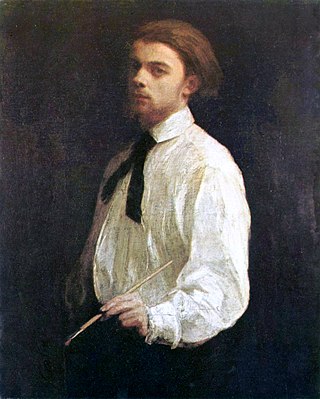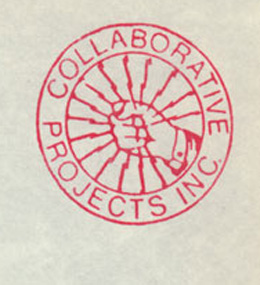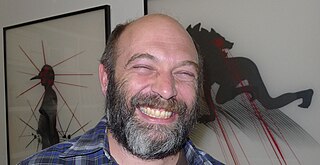
Henri Fantin-Latour was a French painter and lithographer best known for his flower paintings and group portraits of Parisian artists and writers.
Raymond Pettibon is an American artist who lives and works in New York City. Pettibon came to prominence in the early 1980s in the southern California punk rock scene, creating posters and album art mainly for groups on SST Records, owned and operated by his older brother, Greg Ginn. He has subsequently become widely recognized in the fine art world for using American iconography variously pulled from literature, art history, philosophy, and religion to politics, sport, and sexuality.
Anya Gallaccio is a British artist, who creates site-specific, minimalist installations and often works with organic matter.
James Jean is a Taiwanese-American visual artist working primarily in painting and drawing. He lives and works in Los Angeles, where he moved from New York in 2003.

Kiki Smith is a German-born American artist whose work has addressed the themes of sex, birth and regeneration. Her figurative work of the late 1980s and early 1990s confronted subjects such as AIDS, feminism, and gender, while recent works have depicted the human condition in relationship to nature. Smith lives and works in the Lower East Side, New York City, and the Hudson Valley, New York State.

Colab is the commonly used abbreviation of the New York City artists' group Collaborative Projects, which was formed after a series of open meetings between artists of various disciplines.

Carlos Amorales is a multidisciplinary artist who studied at the Gerrit Rietveld Academy and the Rijksakademie in Amsterdam. The most extensive researches in his work encompass Los Amorales (1996-2001), Liquid Archive (1999-2010), Nuevos Ricos (2004-2009), and a typographic exploration in junction with cinema (2013–present).
Larry Bell is an American contemporary artist and sculptor. He is best known for his glass boxes and large-scaled illusionistic sculptures. He is a grant recipient from, among others, the National Endowment for the Arts and the Guggenheim Foundation, and his artworks are found in the collections of many major cultural institutions. He lives and works in Taos, New Mexico, and maintains a studio in Venice, California.
Allan Sekula was an American photographer, writer, filmmaker, theorist and critic. From 1985 until his death in 2013, he taught at California Institute of the Arts. His work frequently focused on large economic systems, or "the imaginary and material geographies of the advanced capitalist world."

Rudolf Harry "Rudi" Staffel was an American ceramic artist and educator.

Robin Rhode is a South African artist based in Berlin. He has made wall drawings, photographs and sculptures.

Dan Owen Dailey is an American artist and educator, known for his sculpture. With the support of a team of artists and crafts people, he creates sculptures and functional objects in glass and metal. He has taught at many glass programs and is professor emeritus at the Massachusetts College of Art, where he founded the glass program.

Erwin Eisch was a German artist who worked with glass. He was also a painter, draughtsman, and printmaker. Eisch's work in glass, along with that of his friend and colleague Harvey Littleton, embodies the ideas of the international studio glass movement. Eisch is considered a founder of the studio glass movement in Europe.
Linda MacNeil is an American abstract artist, sculptor, and jeweler. She works with glass and metal specializing in contemporary jewelry that combines metalwork with glass to create wearable sculpture. Her focus since 1975 has been sculptural objets d’art and jewelry, and she works in series. MacNeil’s jewelry is considered wearable sculpture and has been her main focus since 1996.
David Haines is an English artist who lives and works in Amsterdam. He is known for his videos and large scale pencil drawings on paper.
Coleen Fitzgibbon is an American experimental film artist associated with Collaborative Projects, Inc.. She worked under the pseudonym Colen Fitzgibbon between the years 1973–1980. Fitzgibbon currently resides on Ludlow Street in New York City and in Montana.

Berend Strik is a Dutch visual artist working and living in Amsterdam.

Johannes Jacobus (Jan) van der Vaart was an influential Dutch ceramicist from the 20th century, known as founder of the abstract-geometric ceramics in the Netherlands.
Raha Raissnia is a contemporary artist based in New York City, known for her painting, drawing, filmmaking and performance art. Raissnia manipulates cinema's structural elements in loop installations and live performances. She often alters and tunes the mechanical parts of her film projectors, relying on her hand and playing them similarly to the way musicians play instruments.

The Times Square Show was an influential collaborative, self-curated, and self-generated art exhibition held by New York artists' group Colab in Times Square in a shuttered massage parlor at 201 W. 41st and 7th Avenue during the entire month of June in 1980. The Times Square Show was largely inspired by the more radical Colab show The Real Estate Show, but unlike it, was open 24 hours a day, 7 days a week, in what was then a Times Square full of porno theaters, peep shows, and red light establishments. In addition to experimental painting and sculpture, the exhibition incorporated music, fashion, and an ambitious program of performance and video. For many artists the exhibition served as a forum for the exchange of ideas, a testing-ground for social-directed figurative work in progress, and a catalyst for exploring new political-artistic directions.










